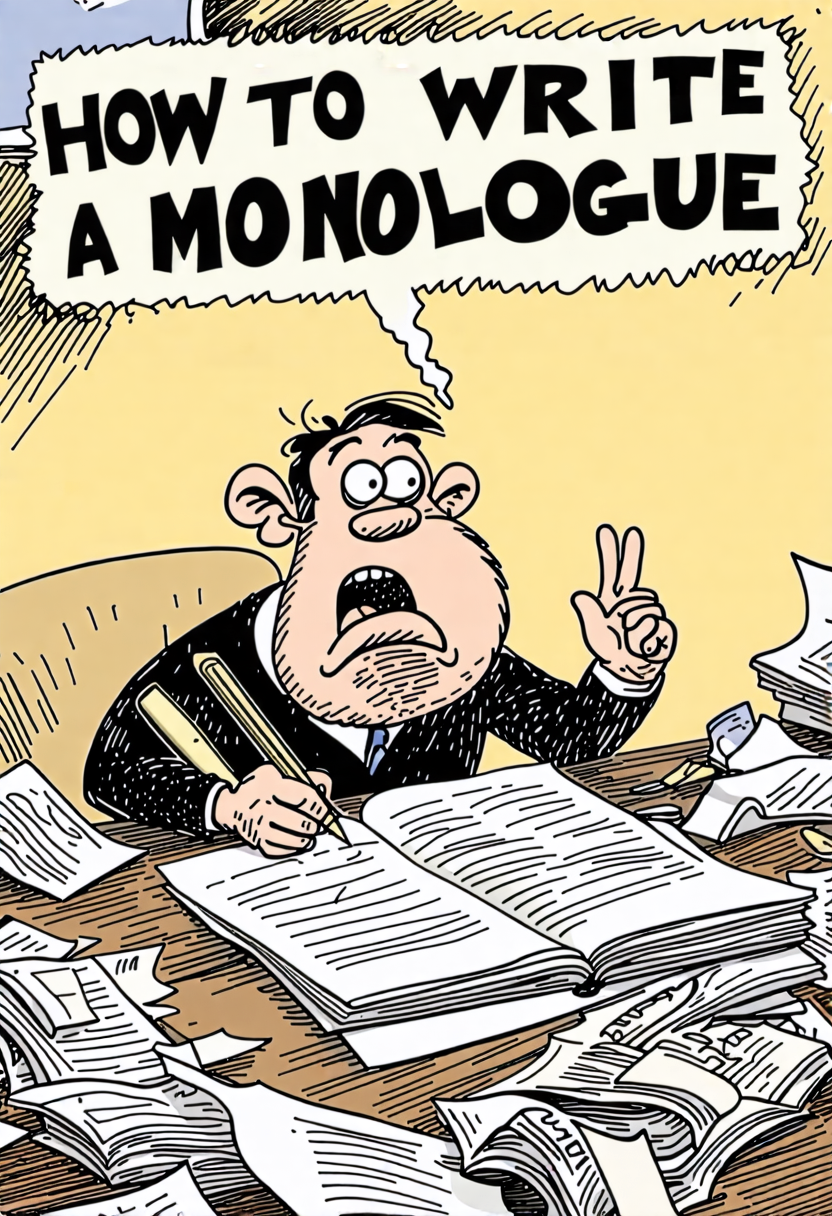How to write a monologue? 7 Easy steps
Start by understanding your monologue’s purpose. Decide if it’s revealing thoughts, driving the plot, or developing the character. Next, dive deep into your character’s background, relationships, and personality. Know your audience—are you addressing them directly or is it introspective? Craft a strong opening line to grab attention. Use storytelling techniques like vivid imagery and pacing to keep it engaging. End with a memorable closing that ties everything together. Finally, revise for clarity and emotional impact. Keep going to discover the finer details of each step.
Understanding Monologues
To understand monologues, you need to know they express a character’s thoughts, feelings, and perspective. They reveal the speaker’s character to the audience.
Monologues appear in theater, books, movies, and stand-up comedy. They can be directed at an audience or be a one-sided conversation with another character.
Types include soliloquies, villain speeches, character songs, poems, and dramatic asides. Each type has its own style and purpose.
For instance, soliloquies let characters speak their inner thoughts aloud. Villain speeches show the antagonist’s motives. Character songs and poems add a lyrical touch. Dramatic asides let characters speak directly to the audience for dramatic effect.
Importance of Monologues
Why are monologues essential in storytelling? They let you dive deep into a character’s mind. This helps the audience understand their motives and feelings. Monologues can reveal secrets, fears, and desires that dialogue mightn’t capture. They give characters a voice to share their inner world.
Using monologues, you can build tension and create emotional connections. They offer a break from the main action, allowing characters to reflect. This enhances the narrative and adds depth.
Monologues also showcase your writing skills. They require you to focus on language and expression. Crafting a compelling monologue can make your story more engaging and memorable. So, don’t underestimate their power in storytelling.
Determine the Goal
Monologues can be powerful tools in storytelling, but you need to determine their goal first. Knowing why your character speaks is essential. Are they revealing a secret, expressing deep emotions, or sharing their worldview? The goal shapes the content and tone.
- Reveal Inner Thoughts: Use the monologue to show what the character thinks but can’t say aloud.
- Drive the Plot: Allow the character to move the story forward or explain vital events.
- Develop the Character: Let the audience understand the character’s motivations and psyche.
Explore the Character
Explore your character’s background to understand their motivations and behavior. Dig into their past. What experiences shaped them? Why do they feel the way they do? Know their relationships with other characters. This helps you write believable and compelling dialogue. It’s vital to understand their strengths, weaknesses, and desires. Think about their goals and fears.
| Character Aspect | Questions to Consider |
|---|---|
| Background | What is their history? |
| Relationships | Who matters to them? |
| Personality | What are their traits? |

Identify the Audience
Knowing who the monologue is addressed to helps shape the tone and content. Consider whether the character is speaking to another character, the audience, or themselves. This choice influences the language, mood, and delivery.
- Direct Address: If the monologue is to another character, make sure the dialogue reflects their relationship and history.
- Breaking the Fourth Wall: When addressing the audience, use a conversational tone. Engage them directly and make them feel involved.
- Introspective: If the character is talking to themselves, the speech should be more reflective and personal. Dive deep into their thoughts and emotions.
Hook the Listeners
Capturing your audience’s attention right from the start is crucial for a compelling monologue. Start with a strong opening line. Use a surprising fact, a bold statement, or a question. This grabs interest quickly.
Keep your tone engaging and direct. Let your character’s emotions shine through right away. Show urgency or tension to make listeners curious. Use vivid imagery to paint a scene in their minds. Make sure your first few sentences set the mood and hint at the conflict.
Avoid lengthy introductions. Get straight to the heart of the matter. By hooking your listeners early, you make sure they stay engaged in your character’s journey and excited to hear more.
Use Storytelling Techniques
How can you make your monologue truly unforgettable? Use storytelling techniques to captivate your audience. These techniques help paint vivid images and evoke emotions.
Follow these steps:
- Figurative Language: Use metaphors, similes, and personification to create powerful imagery. Instead of saying ‘I’m sad,’ say ‘My heart feels like it’s drowning in sorrow.’
- Repetition: Emphasize key points by repeating important words or phrases. This reinforces the message and makes it memorable. For example, ‘I remember the day, every detail, every sound.’
- Pacing: Vary the speed of your speech. Slow down for dramatic moments and speed up for excitement. This keeps the audience engaged and highlights the monologue’s emotional peaks.
End Strongly
Wrap up your monologue with a memorable closing that leaves a lasting impact on your audience. Make sure your ending is clear and powerful. Your character’s final words should resonate. Tie up loose ends and reinforce the monologue’s main theme.
A strong conclusion can be an emotional revelation, a decisive action, or a poignant message. Avoid ending abruptly or with unnecessary details. Think about what you want the audience to remember.
Craft a line or two that sticks with them. This final touch will make sure your monologue feels complete and satisfying. Remember, the ending is your last chance to leave an impression, so make it count.
Revise the Monologue
Revision is crucial to refining your monologue and guaranteeing it resonates with the audience. Start by reading your monologue out loud. This helps you catch awkward phrases and unnatural dialogue. Look for areas where the pacing lags or the message gets muddled.
Here’s a simple checklist to guide your revisions:
- Clarity: Make certain your monologue is easy to understand. Remove any confusing or redundant parts.
- Emotion: Check if the monologue conveys the intended emotions effectively. Adjust the tone and language if needed.
- Flow: Ensure the monologue flows smoothly from start to finish. Revise any choppy or disjointed sections.
Examples of Monologues
Once you’ve polished your monologue, it’s helpful to look at examples from famous works to see how they achieve impact.
Take Shakespeare’s ‘To be or not to be’ from *Hamlet*. This soliloquy explores deep into the character’s inner conflict and existential thoughts.
Another great example is the Phantom’s speech in Andrew Lloyd Webber’s *Phantom of the Opera*. It reveals his pain and longing, creating a powerful emotional connection.
These monologues use strong openings, vivid imagery, and emotional depth. By studying them, you’ll see how structure and content work together to convey powerful messages.
Apply these techniques to make your monologue engaging and memorable.
Frequently Asked Questions
How Long Should a Monologue Be?
A monologue should be concise yet impactful. Aim for 1-2 minutes in performance, around 150-300 words. Keep it engaging and to the point, ensuring it reveals the character’s feelings and perspective effectively.
Can a Monologue Include Dialogue?
Yes, a monologue can include dialogue. You might have the character recall or narrate a conversation. This helps convey more depth and context to the character’s thoughts and feelings. Just keep it focused and relevant.
Are There Common Mistakes to Avoid in Monologues?
Yes, there are common mistakes you should avoid in monologues. Don’t make it too long or irrelevant. Avoid clichés and overacting. Make sure it sounds natural and stays true to the character’s voice and situation.
How Do You Handle Stage Directions in a Monologue?
When handling stage directions in a monologue, keep them clear and concise. Use them to highlight key actions or emotions. Don’t overdo it. Let the actor interpret and bring the character to life.







